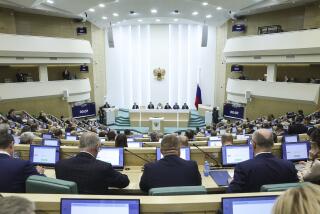Soviet Scientists in U.S. for Seismic Tests
- Share via
WASHINGTON — Bearing more than a ton of seismic equipment, a team of nine Soviet scientists arrived in the United States on Wednesday to conduct a series of privately funded experiments designed to prove that the superpowers could verify a nuclear test ban.
As part of an unprecedented cooperative effort between independent U.S. scientists and members of the Soviet Academy of Sciences, the Soviet team will establish a seismic listening post at Deep Springs, an area near Bishop, Calif., 120 miles from the Nevada test site where the U.S. Energy Department conducts underground nuclear blasts to test the reliability of nuclear warheads.
To determine how easily American nuclear tests could be detected and measured, the scientists will conduct as many as three underground blasts on leased land in Nevada near the test site, using chemical rather than nuclear explosives, on April 29 and 30. The chemical blasts are designed to mimic the effects of testing very small nuclear weapons.
From their seismic station, Soviet scientists and those from the Washington-based Natural Resources Defense Council will gather and compare data that will allow them to determine how many seismic stations would be required to monitor an agreement that would ban or set extremely low limits on the size of nuclear test blasts.
“We have to measure, in effect, how far away you can hear a pin drop, and then gauge how many people you might need to have in a room to hear a pin drop anywhere,” said Thomas B. Cochran, the American co-director of the test ban project.
The independent scientific effort comes as U.S. and Soviet arms negotiators in Geneva are trying to resolve what the Reagan Administration has called “outstanding issues” on the verification procedures that the superpowers would follow on the Threshold Test Ban Treaty. The treaty, signed in 1974 but never ratified, would set a threshold of 150 kilotons on nuclear test explosions.
Moratorium Premature
The Reagan Administration says it is premature to consider a moratorium on nuclear tests, arguing that Washington could not confidently catch the Soviets if they decided to cheat on such an agreement. The Soviets have consistently called on Washington to negotiate an outright nuclear test ban.
After observing a unilateral moratorium for 19 months, Moscow restarted its underground test program in February, 1987, although it still urges a moratorium. The United States has continued to test.
The Natural Resources Defense Council, which actively supports a full nuclear test ban, has raised roughly $3.5 million from private foundations to conduct seismic experiments near nuclear test sites in the United States and the Soviet Union. After a yearlong project to collect seismic data in the Kazakhstan region of the Soviet Union, which culminated in three planned chemical underground explosions in September, 1987, the U.S. scientists concluded that the United States could confidently monitor Soviet compliance with a nuclear test ban.
Now the scientists are focusing on tests in the United States.
For this phase, estimated to cost about $200,000, the State Department issued the Soviet seismologists and technicians visas allowing them to travel to Nevada for the first time. When the Soviets first sought visas to travel to the test area in the fall of 1986, the State Department set conditions that they considered unacceptable, including a demand that the Soviets discuss procedures for verifying the threshold test ban treaty.
But with negotiations making progress in Geneva on the treaty, Cochran said the State Department was willing to drop its demands. However, the Reagan Administration remains opposed to a comprehensive test ban. The data collected both in the United States and the Soviet Union are being relayed to the Defense Department, Cochran added, where the results of the experiment have raised interest.
More to Read
Sign up for Essential California
The most important California stories and recommendations in your inbox every morning.
You may occasionally receive promotional content from the Los Angeles Times.














